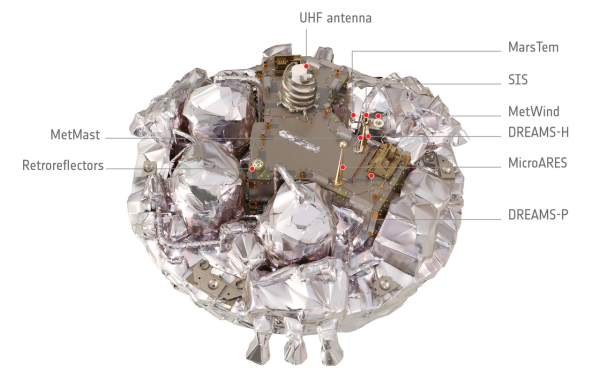Schiaparelli science package and science investigations
Science investigations to be carried on Schiaparelli, the ExoMars entry, descent and landing demonstration module (EDM), were selected in June 2011 following an announcement of opportunity released by ESA and NASA.
The selected investigations consist of a surface payload, called DREAMS, which will operate on the surface of Mars for 2–8 sols, and an investigation known as AMELIA, for entry and descent science investigations using the spacecraft engineering sensors.
A separate instrumentation package, COMARS+, will monitor the pressure, surface temperature and heat flux on the back cover of Schiaparelli as it passes through the atmosphere.
In addition, the descent camera (DECA) on Schiaparelli will image the landing site as it approaches the surface, as well as providing a measure of the atmosphere’s transparency. DECA is the re-named flight spare of the visual monitoring camera which flew on Herschel.
A compact array of laser retroreflectors, known as INRRI, is attached to the zenith-facing surface of Schiaparelli. This can be used as a target for future Mars orbiters to laser-locate the module.
DREAMS: the Schiaparelli surface payload
The Schiaparelli surface payload, the DREAMS (Dust Characterisation, Risk Assessment, and Environment Analyser on the Martian Surface) package, consists of a suite of sensors to measure the wind speed and direction (MetWind), humidity (DREAMS-H), pressure (DREAMS-P), atmospheric temperature close to the surface (MarsTem), the transparency of the atmosphere (Solar Irradiance Sensor, SIS), and atmospheric electrification (Atmospheric Radiation and Electricity Sensor; MicroARES).
DREAMS will provide the first measurements of electric fields on the surface of Mars (with MicroARES). Combined with measurements (from SIS) of the concentration of atmospheric dust, DREAMS will provide new insights into the role of electric forces on dust lifting, the mechanism that initiates dust storms.
In addition, the DREAMS-H sensor will complement MicroARES measurements with critical data about humidity; this will enable scientists understand better the dust electrification process.
Read more about the DREAMS experiment in this interview with the Principal Investigator, Francesca Esposito.
|
DREAMS sensors in brief |
|
Principal Investigator:
Project Manager: |
| MetWIND Wind sensor |
| Lead Co-Investigator: Colin Wilson, University of Oxford, United Kingdom |
| Participating countries: Italy, United Kingdom |
| DREAMS-H Humidity sensor |
| Lead Co-Investigator: Ari-Matti Harri, Finnish Meteorological Institute, Finland |
| Participating countries: Italy, Finland |
| DREAMS-P Pressure sensor |
| Lead Co-Investigator: Ari-Matti Harri, Finnish Meteorological Institute, Finland |
| Participating countries: Italy, Finland |
| MarsTem Temperature sensor |
| Lead Co-Investigator: Giacomo Colombatti, CISAS, Università di Padova, Italy |
| Participating countries: Italy |
| SIS – Solar Irradiance Sensor Optical depth single sensor – This will measure the concentration of atmospheric dust |
| Lead Co-Investigator: Ignacio Arruego, INTA, Madrid, Spain |
| Participating countries: Italy, Spain |
| MicroARES Atmospheric charging – This sensor will provide the first measurements of the electric fields on the surface of Mars |
| Lead Co-Investigators: Franck Montmessin, LATMOS, France; Olivier Witasse, ESA-ESTEC, Noordwijk, The Netherlands |
| Participating countries: Italy, France, the Netherlands |
AMELIA: Schiaparelli entry and descent science investigations
The Schiaparelli Entry and Descent Science Team, will carry out a programme, known as AMELIA (Atmospheric Mars Entry and Landing Investigation and Analysis), to study Schiaparelli’s engineering data to reconstruct its trajectory and determine atmospheric conditions, such as density and wind, from a high altitude to the surface. These measurements are key to improving models of the Martian atmosphere.
Read more about AMELIA in this interview with the Principal Investigator, Francesca Ferri.
| Principal Investigator: Francesca Ferri, Università di Padova, Italy |
|
Co-Principal Investigator (modelling):
Co-Principal Investigator (assimilation): |
| Participating countries: Italy, France, Belgium, United Kingdom, United States of America, Germany, Finland |
COMARS+: the Combined Aerothermal and Radiometer Sensors Instrument Package
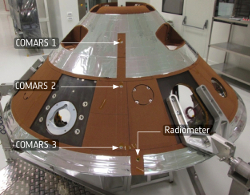 |
| The COMARS sensors and radiometer on the rear cover of Schiaparelli. Credit: DLR – T. Thiele |
Determining what happens to Schiaparelli's external surface as it penetrates the Martian atmosphere and descends to the surface is essential in order to understand the engineering and physics required to make entry, descent, and landing on Mars a success. The Combined Aerothermal and Radiometer Sensors Instrument Package, COMARS+, which is installed on the back cover of Schiaparelli will gather the data to study this.
COMARS+ consists of three small (22-mm-diameter) combined sensors (COMARS) spaced equally across the rear cover of Schiaparelli, one broadband radiometer, and an electronic box. The entire package weighs 1.73 kg and draws 4.5 W of power.
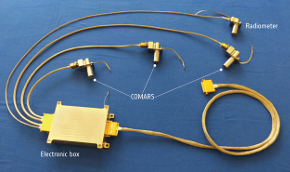 |
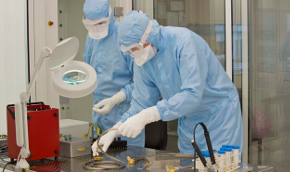 |
| Left: The COMARS+ flight hardware. Credit: DLR – F. Siebe; Right: Assembling the COMARS+ package in a cleanroom. Credit: ESA | |
The pressure on the back cover of the Schiaparelli module, its surface temperature, the rate at which heat energy is transferred to the surface (total heat flux rate), and the amount of radiated heat from the hot gas to the back cover (radiative heat flux) will all be measured with these sensors, which also contain two narrow band radiometers called ICOTOM. The in-flight data will not only allow for a better understanding of the module's performance but will also allow for health-monitoring during flight. The measurements will begin outside the atmosphere and will be performed until the back cover separates from the craft at an altitude of around 1200 metres.
| Team Leader: Ali Gülhan, DLR |
| The COMARS+ package is provided by the German Aerospace Center, (Deutsches Zentrum für Luft- und Raumfahrt; DLR). |
DECA: the Descent Camera on Schiaparelli
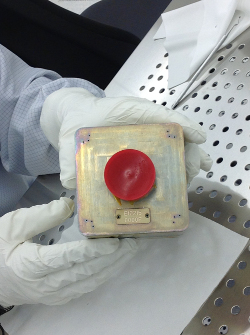 |
| DECA: the Descent Camera on Schiaparelli. Credit: ESA |
DECA is the flight spare of the visual monitoring camera, which flew on the Herschel spacecraft. This camera (mass of 0.6 kg and dimensions of about 9 cm × 9 cm × 9 cm) will be used to image the Martian surface as it approaches the landing site, to determine the transparency of the Martian atmosphere, and to support the generation of a 3-D topography model of the surface of the landing region.
DECA will start taking images shortly after the front-shield of Schiaparelli has been jettisoned during the journey through the Martian atmosphere to the planet's surface. It will take 15 images at 1.5 s intervals, and these images will be stored in local memory. To avoid electrostatic discharges affecting the instrument, there will be a delay of several minutes after Schiaparelli has landed on the surface of Mars, before the data are read out by Schiaparelli's computer and subsequently downlinked to Earth.
| Team Leader: Detlef Koschny, ESA |
| DECA was designed and built by Optique et Instruments de Précision (OIP) in Belgium for ESA and provided to the ExoMars mission by the Scientific Support Office of ESA's Directorate of Science. |
INRRI: the INstrument for landing - Roving laser Retroreflector Investigations
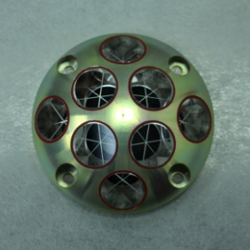 |
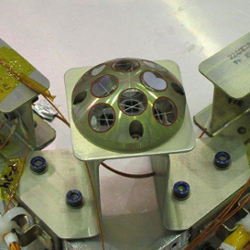 |
|
The INRRI retroreflector, before (above) and after (below) installation on Schiaparelli. Credit: INFN (above); Thales Alenia Space (below) |
INRRI is a Cube Corner laser Retroreflector (CCR) located on the zenith-facing surface of Schiaparelli, the ExoMars entry, descent, and landing demonstrator. It will enable Schiaparelli to be located from Mars orbiters by laser ranging, both during Schiaparelli’s mission lifetime and, as it is passive and maintenance free, afterwards.
INRRI will act as a fixed point on the Martian surface that can be available over the long term for optical detection by future experiments, for example in the fields of Martian geodesy or general relativity. Retroreflectors placed on the Moon by the Apollo astronauts and Lunokhod rovers for similar purposes are still in use.
This will be the first time that a retroreflector has been placed on Mars.
INRRI may also be useful to support testing and diagnostics of laser communications between Mars orbit and the surface, as well as atmospheric trace species detection from orbiting lidars. Monitoring changes in the reflectivity of INRRI may also yield information about dust accumulation and removal.
INRRI is very compact and lightweight, and has the form of a dome with a diameter of about 54mm and a total mass of 25g. It has an aluminium body with eight Suprasil1 (fused silica) CCR’s mounted within it using silicone rubber.
| Team Leader: Simone Dell'Agnello, INFN-LNF, Frascati, Italy |
| INRRI was designed and built by the SCF_Lab of the Istituto Nazionale di Fisica Nucleare - Laboratori Nazionali di Frascati (INFN-LNF) in Italy for ESA. It is provided to the ExoMars mission by the Italian space agency, ASI. |

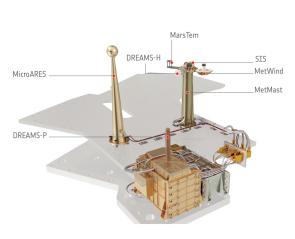
.jpg)
